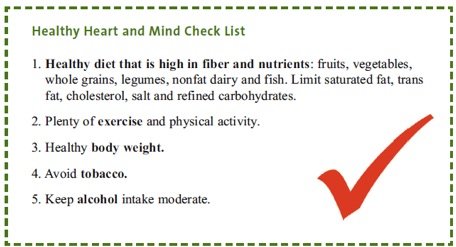Saving Heart and Mind
 For more than 50 years, heart disease has killed more Americans than any other disease. The #3 killer for the same time period has been strokes. While most strokes are not fatal, most nonfatal strokes destroy part of the brain leading to the loss of cognitive function and/or physical disabilities. We have known for many years that both strokes and heart disease are primarily caused by a typical modern diet high in saturated and hydrogenated fats, cholesterol and excess salt. Plus it contains too little high-fiber and nutrient-rich foods like whole grains, fruits, vegetables, nonfat dairy, and moderate amounts of seafood. In addition, it has been proven that other lifestyle factors such as tobacco, excess alcohol, inactivity, and excess body weight promote these diseases.
For more than 50 years, heart disease has killed more Americans than any other disease. The #3 killer for the same time period has been strokes. While most strokes are not fatal, most nonfatal strokes destroy part of the brain leading to the loss of cognitive function and/or physical disabilities. We have known for many years that both strokes and heart disease are primarily caused by a typical modern diet high in saturated and hydrogenated fats, cholesterol and excess salt. Plus it contains too little high-fiber and nutrient-rich foods like whole grains, fruits, vegetables, nonfat dairy, and moderate amounts of seafood. In addition, it has been proven that other lifestyle factors such as tobacco, excess alcohol, inactivity, and excess body weight promote these diseases.Nevertheless, Americans have, for the most part, lived in denial of these truths. Perhaps they naively believe that modern medicine can save them from these cardiovascular diseases (CVD). The truth is most scientific research shows medical treatments (surgery and drugs) for CVD may slow them down and/or reduce their symptoms but these medical treatments have proven to have little impact on life expectancy. The sad truth is that most Americans are overly optimistic about the likely impact of drugs and surgery on deaths and disabilities caused by heart disease and strokes. If these treatments were really effective heart disease and stroke would not still be the #1 and #3 killers of Americans today.Alzheimer’s Disease Has Similar Risk Factors as CVDThe latest headlines about Alzheimer’s disease (AD) discuss a study published in the journal of Science (8/10/06), which found that the beta-amyloid protein believed to cause AD is due to a slowdown in the “work” of molecular “janitors” (e.g. HSF-1).Dr. Andrew Dillin at the Salk Institute for Biological Research conducted the research in roundworms. He found the reduction in HSF-1 appears due in part to higher levels of insulin and insulin-like growth factor-1 (IGF-1) as well as the natural aging process. Dr. Dillin stated, “By the time you see [beta-amyloid] plaques, it’s too late.” Now scientists will try to develop drugs that can stimulate the production of HSF-1 in the hope that it will at least slow the build-up of these plaques. If successful these drugs may slow the progression of AD much like cholesterol and blood pressure lowering drugs slow the progression of atherosclerosis and modestly reduce the risk of CVD. However, insulin levels and IGF-1can be lowered today with exercise, a healthier diet, and weight loss.On August 11, 2006, Dr. Arthur Kramer reported his findings from a comprehensive review of the scientific literature on physical activity and loss of mental function at the American Psychological Association’s 114th Annual meeting. He reported that physical activity may slow aging’s effects on mental function and that physical training appears to improve mental function. Exercise improves insulin sensitivity and lowers insulin and IGF-1 levels. Higher levels of these hormones appear to reduce HSF-1, which results in faster aging of the brain and an increased risk of AD and senility.Another study done at the Karolinska Institute in Sweden and reported in Lancet in August 2006 examined 1,409 people around age 50 and then followed them another 20 years. Mental function was measured at the beginning and after about 20 years. The best predictors of AD and loss of mental function were high blood pressure, obesity, high cholesterol level and inactivity. Obesity is often associated with insulin resistance and higher levels of insulin and IGF-1. All of these risk factors have previously been shown to promote CVD.Bottom Line:The best way to keep your heart and brain healthy well into old age is to eat a diet high in fruits, vegetables, whole grains, and beans and low in saturated and hydrogenated fats, cholesterol, salt, and refined carbohydrates. Regular exercise, low body fat stores, avoiding tobacco, and only moderate alcohol intake should also help keep your heart and mind in good shape far longer. In addition, unlike drugs and surgery, the evidence is now very strong that these same diet and lifestyle changes can significantly increase overall life expectancy.
